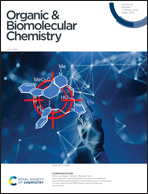Understanding Cu(ii)-based systems for C(sp3)–H bond functionalization: insights into the synthesis of aza-heterocycles†‡
Abstract
Herein we report the synthesis of imidazo[1,5-a]pyridine heterocycles via a Cu(II)-mediated functionalization of α′-C(sp3)–H bonds of pyridinylaldimines and subsequent cyclization. This strategy exploits the inherent directing ability of heteroleptic aldimine and pyridine groups in the substrate yielding the C–H functionalization of α′-methylene groups in a regioselective fashion over distant methyl or methylene groups in β or γ positions. The observed correlation between the nature of the anionic ligands (halide vs. carboxylate) bonded to copper and the chemoselectivity of the C(sp3)–H activation process points to a concerted metalation–deprotonation pathway prior to cyclization to furnish the corresponding imidazo[1,5-a]pyridine derivative. This copper-mediated C(sp3)–H bond functionalization reaction works for a variety of substrates incorporating linear alkyl chains (from 3 to 12 carbon atoms), and good functional group tolerance (aryl, ether and ester groups). Cu-Catalyzed C(sp2)–H cyanation on the imidazole ring can then take place selectively under oxidative conditions.

- This article is part of the themed collection: Catalysis & biocatalysis in OBC


 Please wait while we load your content...
Please wait while we load your content...